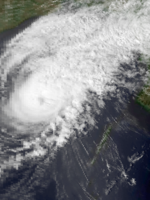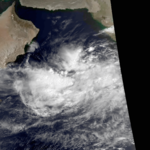1987 North Indian Ocean cyclone season
| 1987 North Indian Ocean cyclone season | |
|---|---|
 Season summary map | |
| Seasonal boundaries | |
| First system formed | January 30, 1987 |
| Last system dissipated | December 23, 1987 |
| Strongest storm | |
| Name | One |
| • Maximum winds | 140 km/h (85 mph) (3-minute sustained) |
| • Lowest pressure | 970 hPa (mbar) |
| Seasonal statistics | |
| Depressions | 9 |
| Deep depressions | 6 |
| Cyclonic storms | 8 |
| Total fatalities | Unknown |
| Total damage | Unknown |
| Related articles | |
The 1987 North Indian Ocean cyclone season was part of the annual cycle of tropical cyclone formation. The season has no official bounds but cyclones tend to form between April and December. These dates conventionally delimit the period of each year when most tropical cyclones form in the northern Indian Ocean. There are two main seas in the North Indian Ocean—the Bay of Bengal to the east of the Indian subcontinent and the Arabian Sea to the west of India. The official Regional Specialized Meteorological Centre in this basin is the India Meteorological Department (IMD), while the Joint Typhoon Warning Center (JTWC) releases unofficial advisories. An average of five tropical cyclones form in the North Indian Ocean every season with peaks in May and November.[1] Cyclones occurring between the meridians 45°E and 100°E are included in the season by the IMD.[2]
Prior to 1992, this season had the most tropical storms in North Indian recorded history, with 8 storms forming.
Systems
Tropical Storm One (1B)
| Very severe cyclonic storm (IMD) | |
| Tropical storm (SSHWS) | |
| Duration | January 30 – February 4 |
|---|---|
| Peak intensity | 140 km/h (85 mph) (3-min) 970 hPa (mbar) |
Tropical Storm One, which developed in the central Bay of Bengal on January 30, turned to the north and reached a peak of 65 mph winds on the 2nd. Vertical shear weakened it to a tropical depression before it hit northern Myanmar on the 4th.
Tropical Storm Two (2B)
| Cyclonic storm (IMD) | |
| Tropical storm (SSHWS) | |
| Duration | May 30 – June 5 |
|---|---|
| Peak intensity | 85 km/h (50 mph) (3-min) 983 hPa (mbar) |
On June 4 65 mph Tropical Storm Two hit Bangladesh, causing little damage or loss of life.
Tropical Storm Three (3A)
| Tropical storm (SSHWS) | |
| Duration | June 4 – June 16 |
|---|---|
| Peak intensity | 95 km/h (60 mph) (1-min) 987 hPa (mbar) |
The monsoon trough spawned a tropical depression on June 4 in the Arabian Sea. It tracked due eastward, becoming a tropical storm later that day and reaching a peak of 60 mph winds on the 6th. The storm turned abruptly northward, turned westward and executed an anticyclonic loop. Vertical shear caused the system to dissipate on the 12th.
Tropical Storm Four (4B)
| Cyclonic storm (IMD) | |
| Tropical storm (SSHWS) | |
| Duration | October 14 – October 16 |
|---|---|
| Peak intensity | 85 km/h (50 mph) (3-min) 991 hPa (mbar) |
A monsoon depression became more tropical on October 14 in the Bay of Bengal. It traveled northwestward, becoming a tropical storm on the 15th and hitting southeastern India as a 50 mph storm that night. It rapidly dissipated over land.
Tropical Storm Five (5B)
| Severe cyclonic storm (IMD) | |
| Tropical storm (SSHWS) | |
| Duration | October 30 – November 3 |
|---|---|
| Peak intensity | 100 km/h (65 mph) (3-min) 984 hPa (mbar) |
65 mph Tropical Storm Five, which developed on October 30 in the Bay of Bengal, made landfall at Nellore on the 2nd, dissipating shortly thereafter. 50 people and 26,000 cattle were reported to be died and 7 lakh people were affected due to the storm.
Tropical Storm Six (6B)
| Severe cyclonic storm (IMD) | |
| Tropical storm (SSHWS) | |
| Duration | November 8 – November 13 |
|---|---|
| Peak intensity | 100 km/h (65 mph) (3-min) 987 hPa (mbar) |
The monsoon trough spawned a tropical depression on November 8 in the southeastern Bay of Bengal. It tracked northward, then turned westward, strengthening to a 60 mph tropical storm before hitting eastern India on the 12th.
Tropical Storm Seven (7A)
| Tropical storm (SSHWS) | |
| Duration | December 2 – December 13 |
|---|---|
| Peak intensity | 85 km/h (50 mph) (1-min) 991 hPa (mbar) |
Tropical Storm Seven, which developed in the western Bay of Bengal on December 2, strengthened in the eastern Arabian Sea to a 50 mph storm. It turned to the northeast, where upper-level winds weakened it to a tropical depression. The depression hit western India, 90 miles south of Bombay, on the 12th, and dissipated the next day without causing any damage.
Tropical Storm Eight (8B)
| Deep depression (IMD) | |
| Tropical storm (SSHWS) | |
| Duration | December 17 – December 23 |
|---|---|
| Peak intensity | 55 km/h (35 mph) (3-min) 997 hPa (mbar) |
The eighth and final storm of the season formed on December 17 northeast of Sri Lanka. It moved westward, and executed an elongated loop lasting 4 days. It briefly reached tropical storm strength before vertical shear weakened it again, and the system hit eastern India on the 23rd.
See also
- North Indian Ocean tropical cyclone
- 1987 Atlantic hurricane season
- 1987 Pacific hurricane season
- 1987 Pacific typhoon season
- Australian cyclone seasons: 1986–87, 1987–88
- South Pacific cyclone seasons: 1986–87, 1987–88
- South-West Indian Ocean cyclone seasons: 1986–87, 1987–88
References
- ^ "Frequently Asked Questions: What is the annual frequency of Cyclones over the Indian Seas? What is its intra-annual variation?". India Meteorological Department. 2012. Archived from the original on May 21, 2015. Retrieved June 8, 2012.
- ^ "Bulletins Issued by Regional Specialized Meteorological Centre (RSMC) – Tropical Cyclones, New Delhi" (PDF). India Meteorological Department. May 25, 2009. Archived from the original (PDF) on 2012-04-12. Retrieved July 16, 2012.
External links
- India Meteorological Department
- Joint Typhoon Warning Center Archived 2015-08-09 at the Wayback Machine















